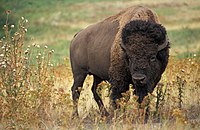
Photo from wikipedia
Abstract Anthrax, caused by the spore-forming bacterium Bacillus anthracis, poses a threat to wood bison (Bison bison athabascae) conservation. We used descriptive epidemiology to characterize a large outbreak of anthrax… Click to show full abstract
Abstract Anthrax, caused by the spore-forming bacterium Bacillus anthracis, poses a threat to wood bison (Bison bison athabascae) conservation. We used descriptive epidemiology to characterize a large outbreak of anthrax in the Mackenzie bison population in the Northwest Territories, Canada, in 2012 and investigated historical serologic exposure of the bison to the bacterium in nonoutbreak years. Between late June and early August 2012, 451 bison carcasses were detected; mortality peaked from 13–19 July. A substantial number of calves, yearlings, and adult females died in the 2012 outbreak, unlike in two previous anthrax outbreaks in this population that killed mostly mature males. On the basis of the difference in estimates of population size prior to the outbreak (2012) and after the outbreak (2013), it is possible that not all dead bison were found during the outbreak. We assessed serologic history of exposure to B. anthracis by using samples from the Mackenzie wood bison population collected between 1986 and 2009. Overall, 87 of 278 samples were positive (31%). Seroprevalence was lower in females (18%, 10/55) than males (36%, 72/203). The highest proportion of positive submissions (90%) was from 1994, the year following the only anthrax outbreak within the historical data set. Both adult males and females had a higher likelihood of being seropositive than the younger age categories. There was a trend toward declining antibody levels between the 1993 and 2012 outbreak years.
Journal Title: Journal of Wildlife Diseases
Year Published: 2017
Link to full text (if available)
Share on Social Media: Sign Up to like & get
recommendations!